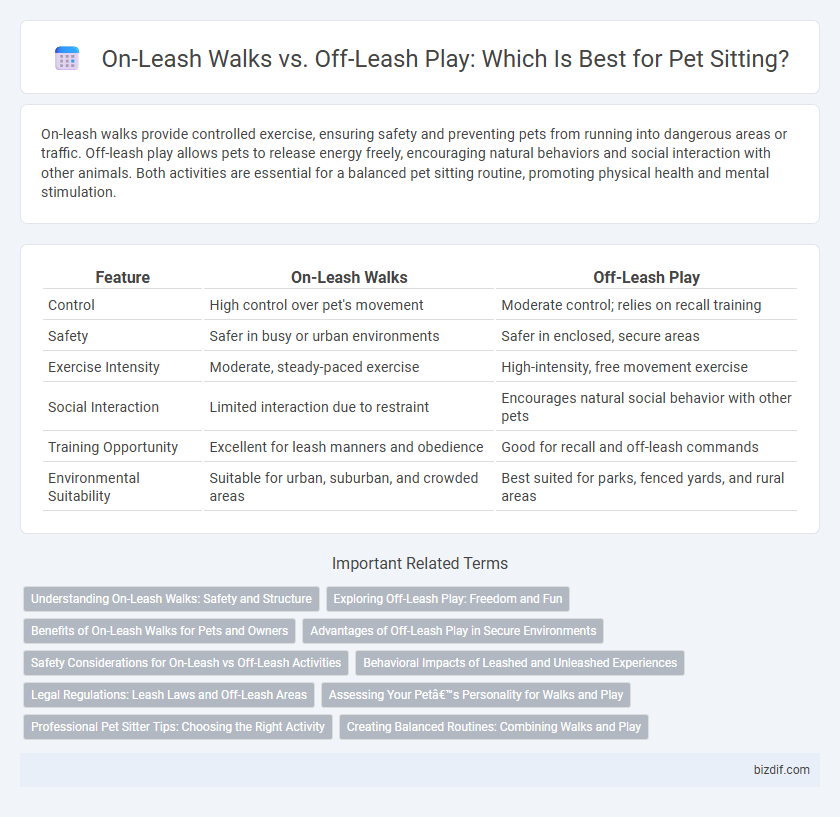On-leash walks provide controlled exercise, ensuring safety and preventing pets from running into dangerous areas or traffic. Off-leash play allows pets to release energy freely, encouraging natural behaviors and social interaction with other animals. Both activities are essential for a balanced pet sitting routine, promoting physical health and mental stimulation.
Table of Comparison
| Feature | On-Leash Walks | Off-Leash Play |
|---|---|---|
| Control | High control over pet's movement | Moderate control; relies on recall training |
| Safety | Safer in busy or urban environments | Safer in enclosed, secure areas |
| Exercise Intensity | Moderate, steady-paced exercise | High-intensity, free movement exercise |
| Social Interaction | Limited interaction due to restraint | Encourages natural social behavior with other pets |
| Training Opportunity | Excellent for leash manners and obedience | Good for recall and off-leash commands |
| Environmental Suitability | Suitable for urban, suburban, and crowded areas | Best suited for parks, fenced yards, and rural areas |
Understanding On-Leash Walks: Safety and Structure
On-leash walks provide essential safety and structure during pet sitting by ensuring pets remain secure and closely monitored. These controlled outings prevent unexpected encounters and help reinforce discipline through consistent leash training. Emphasizing on-leash walks supports a safe environment while promoting positive behavioral habits.
Exploring Off-Leash Play: Freedom and Fun
Off-leash play allows pets to explore their environment freely, promoting physical exercise and mental stimulation. This unrestrained activity enhances socialization skills and reduces anxiety by enabling natural behaviors. Safety measures such as secure fenced areas and supervision ensure a fun and protected off-leash experience.
Benefits of On-Leash Walks for Pets and Owners
On-leash walks provide structured exercise and ensure the safety of pets by minimizing risks such as traffic accidents or encounters with aggressive animals, making them ideal for urban environments. These controlled outings promote better leash manners, reinforce obedience training, and strengthen the bond between pets and owners through consistent communication. Regular on-leash walks contribute to pets' mental stimulation and physical health while offering owners peace of mind and opportunities for socialization.
Advantages of Off-Leash Play in Secure Environments
Off-leash play in secure environments allows pets to exercise natural behaviors, promoting physical health and mental stimulation more effectively than on-leash walks. This freedom enables dogs to socialize, explore, and release energy, reducing stress and behavioral issues. Secure settings ensure safety while maximizing the benefits of off-leash interaction for overall well-being.
Safety Considerations for On-Leash vs Off-Leash Activities
On-leash walks provide controlled environments that reduce the risk of dogs encountering hazards like traffic, aggressive animals, or unsafe terrain. Off-leash play allows for increased freedom and exercise but requires secure, enclosed areas and attentive supervision to prevent injuries or escapes. Choosing between on-leash and off-leash activities depends on the dog's temperament, training level, and the safety of the surrounding environment.
Behavioral Impacts of Leashed and Unleashed Experiences
On-leash walks provide structured exercise that helps reinforce discipline and reduces the risk of aggressive behaviors by maintaining owner control. Off-leash play encourages natural social interactions and mental stimulation, promoting positive engagement and reducing anxiety through freedom of movement. Balancing both experiences supports well-rounded behavioral development, enhancing obedience while allowing dogs to express innate behaviors safely.
Legal Regulations: Leash Laws and Off-Leash Areas
Leash laws vary significantly by location, often requiring dogs to be on-leash in public spaces to ensure safety and compliance with local regulations. Designated off-leash areas, such as certain dog parks and specific trails, provide controlled environments where pets can play freely while owners remain responsible for their behavior. Pet sitters must stay informed about regional laws to avoid fines and ensure the pet's safety during walks and playtime.
Assessing Your Pet’s Personality for Walks and Play
Assessing your pet's personality is crucial when deciding between on-leash walks and off-leash play to ensure safety and enjoyment. Pets with strong recall skills and calm temperaments may thrive during off-leash play, allowing them freedom to explore and socialize, while more anxious or reactive animals benefit from the controlled environment of on-leash walks. Understanding your pet's behavior, energy levels, and responsiveness guides pet sitters in creating tailored exercise routines that promote physical health and mental stimulation.
Professional Pet Sitter Tips: Choosing the Right Activity
Professional pet sitters recommend on-leash walks for controlled exercise and safety in busy or unfamiliar areas, ensuring pets remain secure and responsive. Off-leash play suits secure, enclosed spaces where dogs can freely socialize and expend energy under close supervision, promoting mental and physical stimulation. Choosing between on-leash walks and off-leash play depends on the pet's temperament, environment safety, and specific exercise needs to optimize wellbeing and behavior.
Creating Balanced Routines: Combining Walks and Play
Combining on-leash walks with off-leash play creates a balanced routine that supports a dog's physical and mental well-being. On-leash walks provide controlled exercise and socialization opportunities, while off-leash play encourages freedom of movement and natural behaviors. Incorporating both ensures dogs receive structured activity alongside unrestrained play, promoting overall happiness and health.
On-leash walks vs Off-leash play Infographic

 bizdif.com
bizdif.com